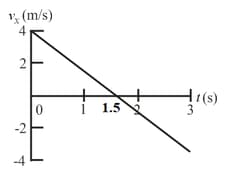Holding on to a towrope moving parallel to a frictionless ski slope, a skier has pulled up the slope, which is at an angle of with the horizontal. What is the magnitude of the force on the skier from the rope when
(a) the magnitude of the skier's velocity is constant at ?
(b) , as increases at a rate of ?

Important Questions on Force and Motion-I
(a) the sledge and the boy?
(b) How far from the boy's initial position do they meet?
A skier skis directly down a frictionless slope angled at to the horizontal. Assume the skier moves in the negative direction of an -axis along the slope. Up the incline is the direction of positive -axis. A wind force with component acts on the skier. What is , if the magnitude of the skier's velocity is:
(a) constant?
(b) increasing at a rate of ?
(c) increasing at a rate of ?
A dated box of dates of mass , is sent sliding up a frictionless ramp at an angle of to the horizontal. In Figure shown below gives, as a function of time t, the component of the box's velocity along an x axis that extends directly up the ramp. What is the magnitude of the normal force on the box from the ramp?

Joyce needs to lower a bundle of scrap material that weighs from a point , above the ground. For doing this exercise, Joyce uses a rope that will break if the tension in it exceeds . Clearly, if she hangs the bundle on the rope, it will break and therefore, Joyce allows the bundle to accelerate downward.
(a) What magnitude of the bundle's acceleration will put the rope on the verge of snapping?
(b) At that acceleration, with what speed would the bundle hit the ground?
In the earlier days, horses pulled barges down the canals in a manner, as shown in the below figure. Suppose the horse pulls on the rope with a force of , at an angle of to the direction of motion of the barge, which is headed straight along the positive direction of the -axis. The mass of the barge is , and the magnitude of its acceleration is . What is the magnitude and direction (relative to positive ) of the force on the barge from the water?

In the figure shown below, a chain consisting of five links, each of mass , is lifted vertically with a constant acceleration of magnitude . Find the magnitudes of
(a) the force on link from link .
(b) the force on link from link .
(c) the force on link from link .
(d) the force on link from link .
Then, find the magnitudes of force on the top link from the person lifting the chain and the net force accelerating each link.

A lamp hangs vertically from a cord in a descending elevator, that decelerates at .
(a) If the tension in the cord is , what is the lamp's mass?
(b) What is the cord's tension, when the elevator ascends with an upward acceleration of ?
